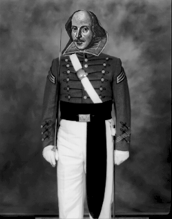
The Shakespeare Room
Welcome to the Shakespeare Room. In this room you will be briefly introduced to Shakespeare, read about his plays, and be referred to a number of websites that focus on Shakespeare and King Lear, in particular.
The Life of Shakespeare
William Shakespeare was born in 1564 to John Shakespeare and his wife, Mary Arden. His father was weathly and held a number of municipal offices. Shakespeare received a good education, but he did not go to the university as many other writers of his time did. Some of these writers ridiculed him and his work because of this. One such example of this ridicule is a pamplet that was published in 1592 by Robert Greene, a famous playwright. In this pamphlet, Greene criticized Shakespeare and his work, a criticism that seems to come mostly from jealosy.
When he was eighteen years old, Shakespeare married Ann Hathaway. Five months later, they had their first child, Suzanna. Two years later, they had twins, Hamnet and Judith.
It is unknown when Shakespeare arrived in London. However, the pamphet published by Robert Greene indicates that he was in London by 1592. The following year, the theaters were closed down due to a plague. By 1594, the theaters were reopened, and they soon began to rise in popularity among the noble class who demanded a better quality theater experience.
It was at this time that Shakespeare's theater company was formed. The company played at Henslowe's Rose Theatre until their lease ran out. They then moved across the river and built the new Globe Theater. Later on, in 1608, they moved into the Blackfriars Theatre where they began producing plays indoors. These plays were in an artificially lit environment, while the Globe Theater had been outdoors, and stage conditions allowed more scenery and a multitude of lighting effects.
In 1596, John Shakespeare was granted a coat of arms. This entitled both he and William to be called by the title of "gentleman." In 1597, Shakespeare bought an estate at Stratford called New Place. He continued to acquire property in Stratford. He wrote his last play, The Tempest in 1611 and he died in 1616.
Shakespeare's Plays
Thirty-seven plays are usually attributed to Shakespeare and they are generally broken down into four categories: the histories, the comedies, the romances, and the tragedies.
The Histories
There are ten history plays in all and they tell the story of England from the fourteenth century through Henry VIII. They are:
Henry VI, Parts I, II and III
Henry IV, Parts I, and II
Richard III
King John
Richard II
Henry V
Henry VIII
The Comedies
To be considered a comedy during the Renaissance, a play needed nothing more than a happy ending and an optimistic point of view. Shakespeare's romantic comedies, which were popular during the period 1595 to 1600, generally revolved around love affairs that were temporarily in trouble. After 1600, the tone of his comedies changed, becoming more somber or dismal. However, since they had happy endings, they were still considered comedies. Shakespeare's comedies are:
Twelfth Night
The Comedy of Errors
The Two Gentlemen of Verona
Love's Labour's Lost
The Taming of the Shrew
A Midsummer Night's Dream
The Merchant of Venice
Much Ado About Nothing
As You Like It
The Merry Wives of Windsor
Troilus and Cressida
All's Well That Ends Well
Measure for Measure
The Romances
The four plays that Shakespeare wrote when his theater company began producing plays at the Blackfriars Theatre in 1608 are known as the Romances. This theater allowed for sets that used more scenery, more lighting effects, and consequently, cost more money. But the better-educated audience that was attending these plays at this point in history demanded extravagant plays with emotional plots, suffering, and happy endings. Shakepeare's Romances are:
Pericles
Cymbeline
A Winter's Tale
The Tempest
The Tragedies
Shakespeare's tragedies were written between 1601 and 1606 and involve parallel plots, symbolism, psychological complexity, and of course, death. Happiness is unheard of in his tragedies, and good and evil are usually clearly separated. The Tragedies are:
Titus Andronicus
Romeo and Juliet
Julius Caesar
Hamlet
Othello
Macbeth
Antony and Cleopatra
Timon of Athens
Coriolanus
King Lear
(from Complete Study Edition: King Lear and An Incomplete Education)
 To visit a website called Shakespeare Illustrated by Harry Rusche, click here. This site includes images of paintings of King Lear and other Shakespearean works. To go directly to the contents page of this site for King Lear only, click here.
To visit a website called Shakespeare Illustrated by Harry Rusche, click here. This site includes images of paintings of King Lear and other Shakespearean works. To go directly to the contents page of this site for King Lear only, click here.
To read King Lear on line, click here.
To continue your tour, click on one of the rooms below:
 To visit a website called Shakespeare Illustrated by Harry Rusche, click here. This site includes images of paintings of King Lear and other Shakespearean works. To go directly to the contents page of this site for King Lear only, click here.
To visit a website called Shakespeare Illustrated by Harry Rusche, click here. This site includes images of paintings of King Lear and other Shakespearean works. To go directly to the contents page of this site for King Lear only, click here.
